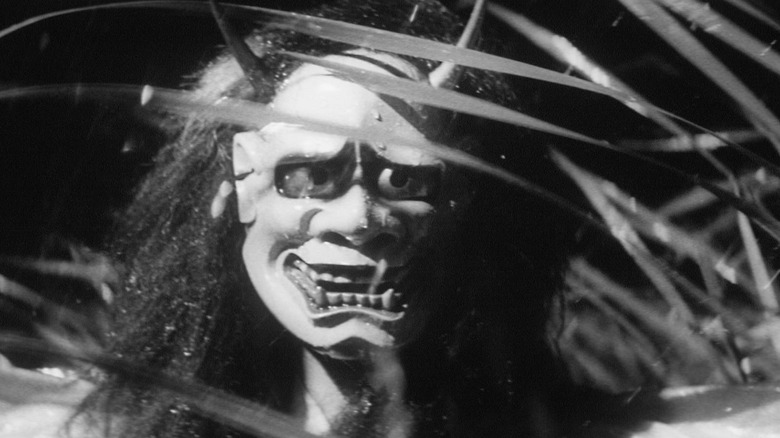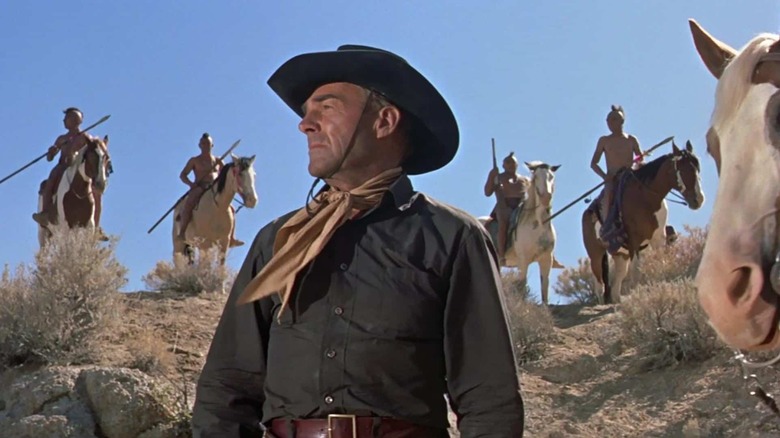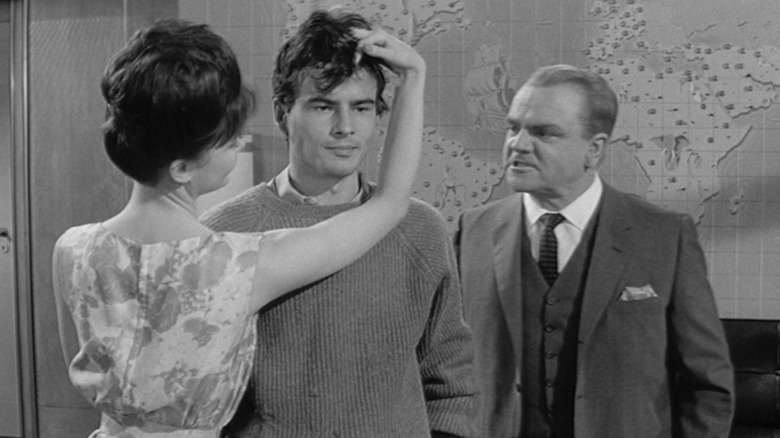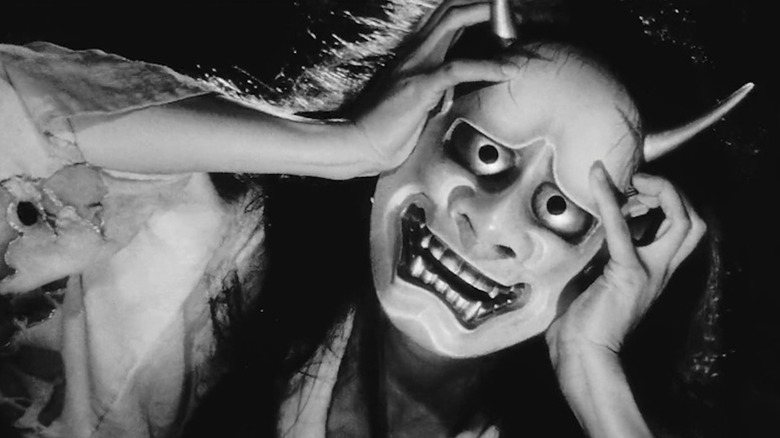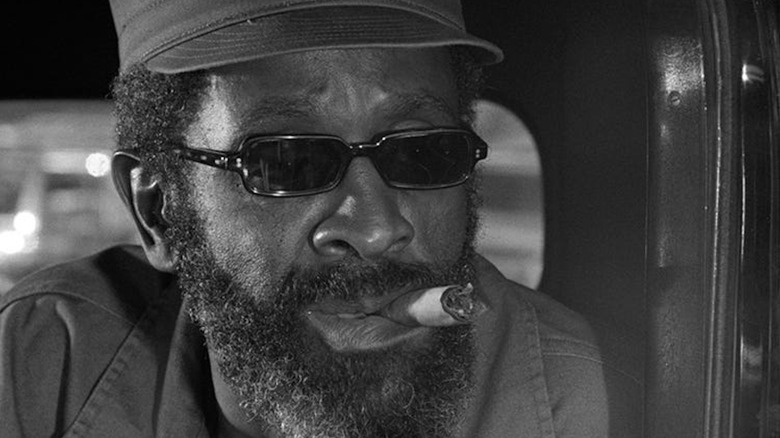'60s Movies Everyone Should Watch At Least Once
The 1960s were a turbulent era of transition across the globe, and this upheaval impacted every single art form save for maybe polka music. (Here's where I find out about an avant-garde electronic polka movement that flourished during the Prague Spring.) It was during this decade that the seeds for the New Hollywood revolution were sown, with exciting, convention-flouting directors like Dennis Hopper, Mike Nichols, and Sergio Leone exploding onto the scene. As the Civil Rights Movement surged forward despite the assassinations of its leaders and cold-blooded murder of four little girls in Alabama, and the U.S. grew more entrenched in the pointless Vietnam War, movies were getting angrier, more subversive, and much more violent.
This was the decade that gave us such classics as "Bonnie and Clyde," "Easy Rider," "The Graduate," "In the Heat of the Night," and "Yojimbo," while the French New Wave ran wild with an onslaught of new releases from boundary-pushing geniuses like Jean Luc-Godard, François Truffaut, and Agnès Varda. Frederico Fellini, Luchino Visconti, and Michelangelo Antonioni were also in their prime, as was Ingmar Bergman. Meanwhile, Stanley Kubrick crafted two stone-cold, game-changing masterpieces in "Dr. Strangelove or: How I Learned to Stop Worrying and Love the Bomb" and "2001: A Space Odyssey."
On top of that, the decade saw old-fashioned Westerns and bloated, soundstage-bound musicals fall out of style, even as the under-the-influence counterculture was served with psychedelic provocations like "The Trip," "Head," and "Wild in the Street." As for the major films of the era not mentioned above, even if you've never seen them, you know the titles, so I needn't recommend them here. But if you're looking for a batch of movies that aren't well known in the mainstream, these superb flicks are emblematic of their times in very different ways.
Comanche Station (1960)
Conventional critical wisdom holds that the tradition Hollywood Western had its swan song with John Ford's 1962 masterpiece "The Man Who Shot Liberty Valance," but you could feel the genre, as it was codified by Ford with 1939's "Stagecoach," was having its last, melancholy hurrah in Budd Boetticher's 1960 film "Comanche Station." This was the final installment in the filmmaker's Ranown Cycle of oaters, all of which — "Seven Men from Now," "The Tall T," "Decision at Sundown," "Buchanan Rides Alone," "Ride Lonesome" — are tough, terse bangers. These films all starred Randolph Scott and, aside from "Buchanan Rides Alone," were written by Burt Kennedy.
In this last Ranown film, Scott stars as Jefferson Cody, a fellow who, while trying to free his kidnapped wife from the Comanches, winds up saving Nancy Lowe (Nancy Gates), whose husband has issued a $5,000 reward for her return. Cody runs across a gang of outlaws led by cold-blooded killer Ben Lane (Claude Akins), who know that the reward for Lowe's return is a "dead or alive" proposition. When Lowe witnesses him commit murder, Lane, looking to avoid the hangman's noose, opts for "dead." Like all of Boetticher's Westerns, "Comanche Station" is short (73 minutes) and motivated by a conflicted protagonist's understanding that decisiveness is key to surviving in this treacherous terrain. It may not be the conclusion some critics wanted for the Ranown cycle, but I think it's the one that Scott, and all the muted variations he played on a Western hero, deserved. (And, really, you should start with "Seven Men from Now" and work your way forward.)
One, Two, Three (1961)
Billy Wilder was fresh off winning Best Picture and Best Director for "The Apartment" (considered by many to be one of the greatest movies ever made) when he hit on the idea to make the fastest comedy of all time. Not the funniest, mind you. The fastest. The film in question was "One, Two, Three," and the only star Wilder believed was capable of driving the sprinting tempo of the picture was James Cagney. The beloved showbiz veteran was in his early 60s at the time, and he was concerned that the rapid pace was a means of covering up a lackluster script. Wilder, however, earned his trust, and the duo was off to the livewire races.
Cagney is a man possessed as Coca-Cola executive C.R. "Mac" MacNamara, who's on a mission to establish the soda as a brand in the Soviet Union; he's also hellbent on becoming the top dog in the company's Western European office. His tireless efforts are complicated when the big boss back in Atlanta asks him to babysit his 17-year-old daughter (Pamela Tiffin) while she travels overseas. The young woman winds up falling for an East German communist (Horst Bucholz, who enraged Cagney throughout the shoot), which, if his boss finds out, will likely cost Mac his job. The complications mount as swiftly as the dialogue gets spit out, and Cagney, brilliant as ever, never misses a beat. Alas, the rigors of the production, which involved loads of takes, left Cagney exhausted; he retired from acting at the end of production and would only make one more on-screen appearance (in Miloš Forman's "Ragtime"). While we might've been robbed of more late-career Cagney performances, "One, Two, Three" is a frenzied delight (with Liselotte Pulver's chaotic strip tease being a highlight).
Onibaba (1964)
Kaneto Shindō's singular classic "Onibaba" (a Willem Dafoe favorite) transforms a Shin Buddhist parable into a deliriously carnal horror movie that does for tall grass what "Jaws" did for the ocean. Nobuko Otowa and Jitsuko Yoshimura star as, respectively, the mother and wife of a man who is away fighting in a bloody Japanese civil war. In his absence, the woman and her daughter-in-law have taken to ambushing returning soldiers who get lost in a pampas grass field; they kill the men, toss their bodies into a bizarrely deep pit, and sell their armor to a local shopkeeper.
These ladies have a decent racket going until their neighbor, Hachi, who was drafted at the same time as the younger woman's husband, returns home with news that her beloved was killed in combat. Hachi wastes no time in trying to seduce the widow, which upsets the mother, primarily because she worries Hachi will take her partner-in-crime away and ruin their diabolical business arrangement. When the young woman lowers her defenses, Shindō dials up the eroticism and elevates the sense that something supernatural may be at play here. From this point forward, "Onibaba" is a wholly unpredictable, exhilaratingly eerie experience that builds to an unforgettable climax. It's a pioneering piece of J-horror, but quite unlike movies like "Pulse" or "Ringu" (though that pit might call to mind the well from the latter). Dim the lights, put your phone away, and let Shindō cast his macabre spell.
The President's Analyst (1967)
American conspiracy theory culture didn't start with President John F. Kennedy's assassination (John Frankenheimer's "The Manchurian Candidate" came out a year prior), but this tragedy, coupled with the subsequent, televised murder of prime suspect Lee Harvey Oswald by nightclub owner Jack Ruby, stoked all manner of suspicions that only got more overheated in the years to come. This kind of thinking would give us a stream of terrific paranoid thrillers in the 1970s, but the sense that shadowy, all-powerful types were controlling the world was grist for Theodore J. Flicker's wildly inventive 1967 satire "The President's Analyst."
In terms of its targets, Flicker's dark comedy is clearly dated. Nevertheless, people viewed the Bell Telephone Company (aka "Ma Bell") as an unsettlingly large, monopolistic corporation 60 years ago. What does any of this have to do with the President of the United States needing a therapist? You just have to roll with the film's unfettered zaniness, which is easy to do when the title role is played by a totally game James Coburn. The actor's Dr. Sidney Schaefer performs his job to the best of his abilities, but, as "The Sopranos" reminded us from time to time, therapists need therapy, too. This proves problematic for Schaefer, as there's no one in the world with security clearance he can share his own emotional distress with. This leads to him escaping his handlers and going on a strange journey that brings him into contact with agents seeking to either kill or recruit him, a pack of hippies and, yes, the phone company. You'll be grinning as Flicker puts Coburn through a surreal ordeal, while also getting a palpable feel for the decade's counterculture movement. "The President's Analyst" is a lot, but, hey, Roger Ebert gave it four stars!
Putney Swope (1969)
One year after the jarring protests and police brutality that turned the Chicago Democratic National Convention into a battleground, guerilla filmmaker Robert Downey Sr. delivered the decade's brashest, most fearless political satire — and if anyone of any ideological persuasion thought the film would cater to their firmly held beliefs, they quickly learned Downey had no interest in taking one side. Perhaps inspired by the anarchic, gleefully profane comedy of bomb thrower Lenny Bruce, Downey's film is radical in its (hardly revolutionary) view that too much power corrupts everyone. In this case, it's the title character (Arnold Johnson) who assumes control of a major advertising firm because his white colleagues botch the board vote.
Swope rechristens the company "Truth and Soul, Inc.," fires all the white folks, and replaces them with Black employees that are all over the board politically. Downey shot the film in black-and-white, switching to color only for the outrageously obscene commercials produced by his colleagues. (The Face-Off pimple cream advertisement, shot like any random spot from the era, will have you howling.) Swope's management style is erratic and ultimately self-contradictory, which leaves him open to harsh criticism from a board member known only as The Arab (the great Antoine Fargas). Downey's out to push lots of buttons, and it's likely he'll piss you off as much as he makes you laugh. But that's what the best counterculture satire of that era tends to do.
